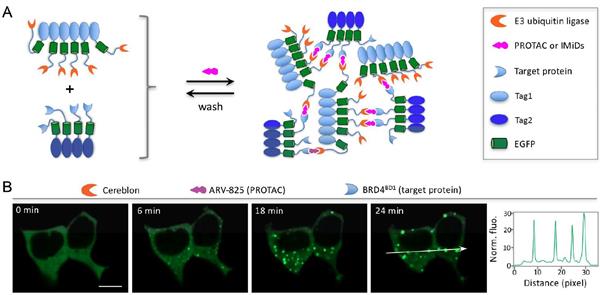"PROTAC-SPARK": A Genetically-encoded Fluorescent Reporter Platform for Studying PROTAC Interaction Kinetics in Living Cells
- 技術優勢
- PROTAC technology is emerging as a novel therapeutic method to target diseases caused by the abnormal expression of a disease-causing proteins. PROTACs simultaneously bind a target protein and its E3-ubiquitin ligase, causing ubiquitination and degradation of the target protein. Studying protein-protein interaction (PPI) kinetics of PROTACs in living cells will reveal critical information about cell signaling dynamics and cellular mechanisms in both normal and disease conditions. Genetically-encoded fluorescent reporters are ideal for these purposes because they allow non-invasive imaging. However, many PPI reporters have limited dynamic range because of their small fluorescence ratio change of acceptor over donor fluorophores. Transcription-based PPI reporters have poor temporal dynamics, at the timescale of hours, and are not reversible. Therefore, there is a great need for improved fluorescent reporters for imaging of dynamic cell signaling processes and PPIs. ADVANTAGES OF THE TECHNOLOGY: Modular platform enables highly customizable reporter designFast kinetics, large dynamic range (fluorescence change), intense brightness, and simple signal pattern enables quantitative and robust visualization of PPIsRapid and reversible system allows investigation of protein-protein dissociation/inactivation kineticsApplicable to live cells so that PPIs are detected in the biological context
- 詳細技術說明
- The Shu lab at UCSF has developed a novel class of genetically-encoded fluorescent reporters that phase separate upon protein interaction. Dubbed “SPARK” (Separation of Phases-based Protein Interaction Assay with Reversible Kinetics), the modular platform can be easily customized to test a large array of PROTACs and visualize the interaction kinetics. Short peptide Homo-oligomeric Tags (HO-Tags) and a fluorescent protein (e.g. GFP), are genetically fused to protein of interest and its respective E3 ligase, which introduces multivalency. Upon PROTAC addition, the multivalent PPI leads to GFP phase separation, resulting in highly concentrated droplets (reversible upon PPI inhibition), forming bright puncta within the cell.
- *Abstract
-
This novel class of genetically-encoded fluorescent reporters can be used as powerful tools to study kinetics of protein targeting chimeras (PROTACs) in living cells. These bright, reversible reporters have a large dynamic range and fast kinetics, demonstrating significant advantages over traditional FRET-based fluorescent reporters. This highly-customizable reporter system is ideal for designing novel cell assays to quickly test protein-protein interactions with quantitative results.
- *Principal Investigation
-
Name: Xiaokun Shu
Department:
Name: Qiang Zhang
Department:
- 其他
-
Stage of Development
Proof of Concept
Looking for Partners
To develop & commercialize the technology as a tool for drug discovery and research.
Data Availability

Related Materials
Related Technologies
Additional Technologies by these Inventors
- INFRARED FLUORESCENT PROTEASE REPORTERS FOR DEEP TISSUE IMAGING
- A Novel Reversible Fluorescent Protein Complementation Assay for Imaging of Protein-protein Interactions
- “SPARK (Separation of Phases-based Activity Reporter of Kinase)”_A Genetically-encoded Fluorescent Reporter Platform for Studying Cell Signaling in Living Cells
Tech ID/UC Case
29405/2018-007-1
Related Cases
2018-007-1
- 國家/地區
- 美國

欲了解更多信息,請點擊 這裡





